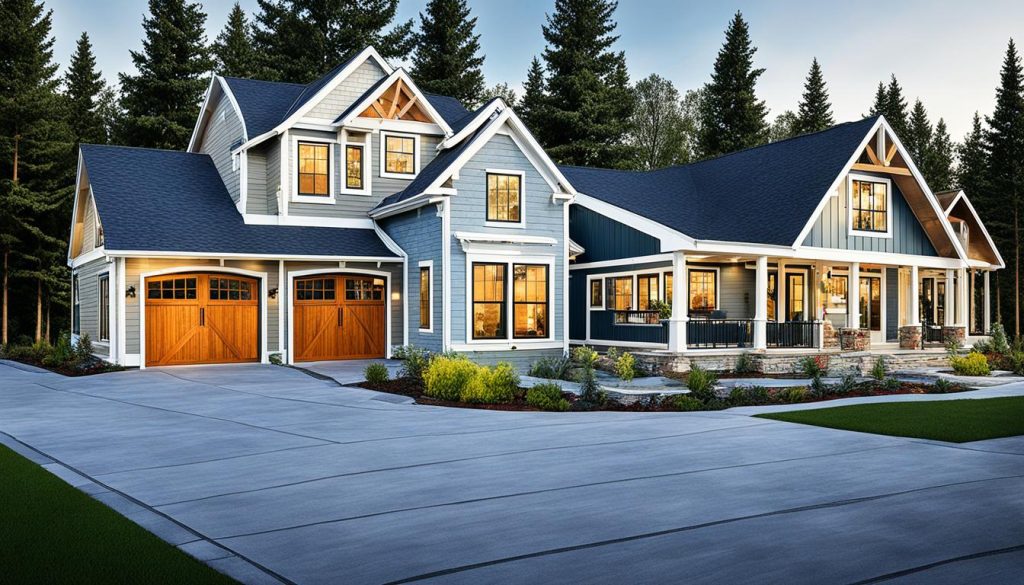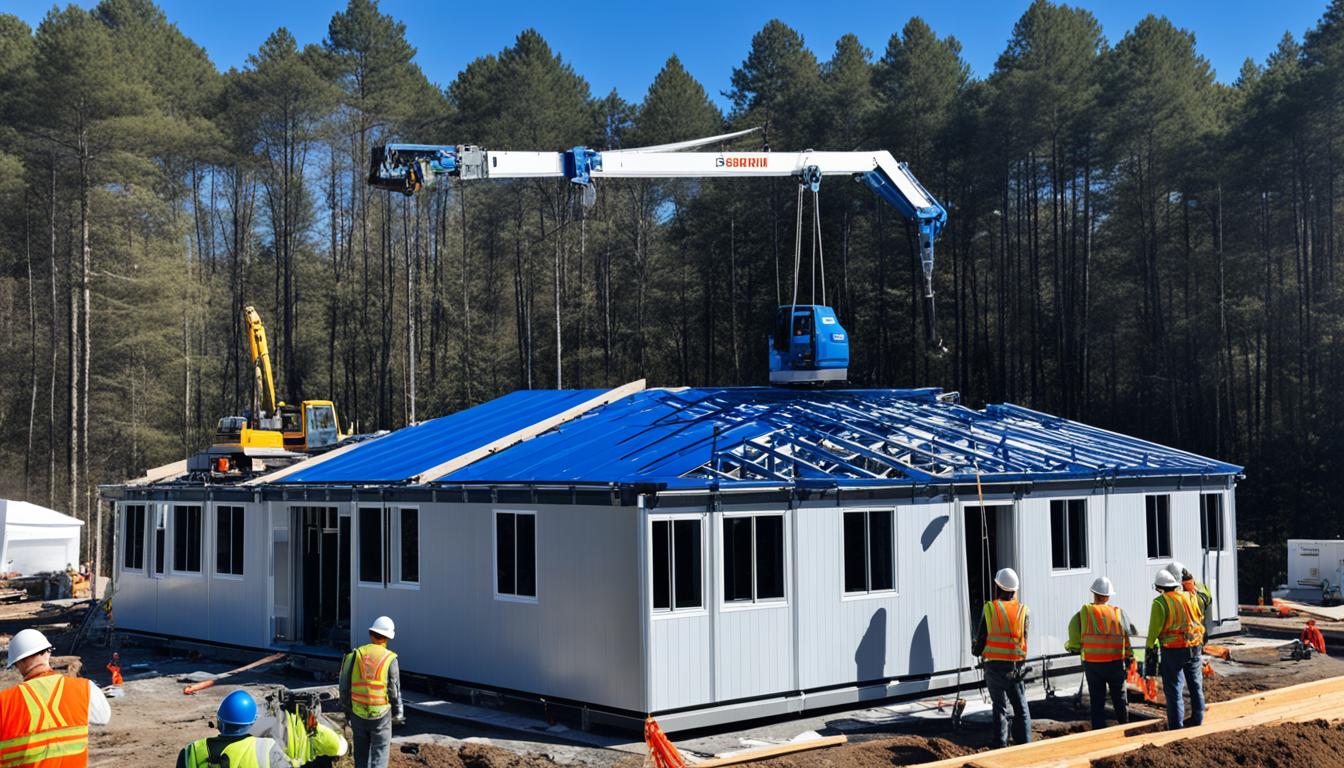Did you know that modular homes offer a cost-effective alternative to traditional site-built homes, with potentially lower prices and faster construction times? Building a modular home has become increasingly popular, providing homeowners with customizable options and energy-efficient designs. If you’re considering building a home, you won’t want to miss out on the benefits of modular construction.
Key Takeaways:
- Modular homes are a cost-effective and customizable alternative to traditional site-built homes.
- They are constructed in modules or sections in a factory and then transported to the building site for assembly.
- Modular homes adhere to the same building codes as traditional homes and can be designed to be energy-efficient.
- They offer faster construction times and potentially lower prices compared to conventional site-built homes.
- Modular homes provide a practical and affordable housing solution that combines quality, customization, and efficiency.
What are Modular Homes?
Modular homes are prefabricated homes constructed off-site in a factory setting, in modules or sections, and then transported to the building site for assembly. They are built following the same building codes and standards as traditional site-built homes.
Modular homes offer homeowners the opportunity to customize their living space to meet their specific needs and preferences. They come in various sizes and styles, allowing individuals to choose a design that suits their lifestyle.
One of the key advantages of modular homes is their energy efficiency. These homes are built with energy-saving features and materials, resulting in potential utility cost savings for homeowners.
By utilizing modular construction methods, manufacturers can streamline the building process while maintaining high-quality standards. The controlled environment of the factory ensures that each module is constructed with precision and attention to detail.
Overall, modular homes offer an efficient and customizable solution for those looking to build their dream home. With their adherence to building codes, design flexibility, and energy efficiency, modular homes continue to gain popularity in the housing market.
Modular Homes v/s Prefabricated Structures
When it comes to the world of construction, modular homes and prefabricated structures are often mentioned interchangeably. However, it’s important to understand that modular homes are a specific type of prefabricated structure with unique characteristics. While they share similarities in terms of their off-site construction process, modular homes stand apart from other prefabricated structures due to their construction method, transportation, and adherence to building codes and standards.
Modular homes are built in modules or sections within a factory setting, following the same building codes and regulations as traditional site-built homes. These modules are then transported and assembled on a permanent foundation at the building site. This process ensures that modular homes meet rigorous quality control measures and provide the same level of structural integrity and durability as site-built homes.
Key Differences between Modular Homes and Other Prefabricated Structures
- Construction Process: Modular homes are constructed in modules or sections within a factory, while other prefabricated structures may use different construction methods such as panelized or manufactured components.
- Transportation: Modular homes are transported to the building site as fully constructed modules, allowing for efficient transportation and easier assembly. Other prefabricated structures may require additional on-site assembly.
- Building Codes and Standards: Modular homes are subject to the same building codes and standards as traditional site-built homes, ensuring compliance with local regulations. This distinction sets them apart from other types of prefabricated structures.
By understanding the unique qualities of modular homes, homeowners can make informed decisions about their housing options. The flexibility, cost-effectiveness, and adherence to building standards make modular homes an appealing choice for those seeking customizable and high-quality housing solutions.
Take a look at the comparison table below for a clearer understanding of the differences between modular homes and other prefabricated structures.

| Modular Homes | Other Prefabricated Structures | |
|---|---|---|
| Construction Process | Constructed in modules or sections within a factory | May use different methods such as panelized or manufactured components |
| Transportation | Transported as fully constructed modules | May require additional on-site assembly |
| Building Codes and Standards | Subject to the same codes and standards as traditional homes | Varies depending on the specific type of structure |
Construction Process of Modular Homes
Building a modular home involves a step-by-step construction process that combines efficiency, quality control, and adherence to building regulations. Let’s take a closer look at each stage of the construction process:
- Design and Planning: Collaborating with the modular home manufacturer, we create a custom design that perfectly aligns with your requirements. This stage establishes the blueprint and layout of your dream home.
- Factory Construction: The modular home construction takes place in a controlled factory environment, utilizing traditional building materials and techniques. The modules are built with precision and attention to detail, ensuring quality and structural integrity.
- Quality Control: Each module undergoes rigorous quality control measures to meet high standards of craftsmanship and construction. This ensures that the finished home is of superior quality and delivers on durability and longevity.
- Transportation: After completion, the modules are transported to the construction site, ready for assembly. This method of transportation ensures the safe and efficient delivery of the modules to your property.
- Assembly: On-site, the modules are carefully positioned and secured on a prepared foundation. This assembly process is quick, streamlined, and minimizes disruptions to your daily life.
- Finishing: With the modules in place, the finishing touches are applied to your modular home. This includes installing cabinets, floors, fixtures, and connecting electrical and plumbing systems.
- Inspection: To ensure compliance with building codes and regulations, your modular home undergoes a comprehensive inspection. This final step ensures that your home is safe, structurally sound, and meets all necessary requirements.
By following this construction process, we deliver modular homes that are not only customizable, cost-effective, and energy-efficient, but also built to the highest standards of craftsmanship and quality.
| Advantages of the Construction Process | Benefits |
|---|---|
| Efficient Factory Construction | Shorter construction timelines |
| Modular Home Customization | Ability to personalize design and features |
| Quality Control Measures | Superior craftsmanship and durability |
| Transportation and Assembly | Reduced on-site disruptions and faster occupancy |
| Compliance with Building Codes | Meeting regulatory standards for safety and functionality |
| Sustainable Construction | Environmentally friendly materials and energy-efficient design |

Benefits of Modular Architecture
magine building your dream home in record time without compromising on quality or design. That’s the power of modular architecture. With its efficient construction processes and sustainable materials, modular homes offer numerous benefits that make them an attractive option for homeowners.
One of the significant advantages of modular construction is speed. Modular homes can be built much faster than traditional site-built homes, thanks to the streamlined manufacturing process. The modules are constructed in a controlled factory environment, eliminating delays due to weather conditions and other external factors.
Not only are modular homes quick to build, but they also offer cost-effectiveness. The efficient construction methods and standardized design allow for cost savings compared to traditional homes. Additionally, the use of sustainable materials promotes environmental responsibility while keeping costs in check.
When it comes to quality, modular homes shine. The modules undergo rigorous quality control measures throughout the manufacturing process, ensuring that every component meets high standards. This results in a home that is built to last, providing homeowners with peace of mind and long-term durability.
Modular homes also offer flexibility in design and construction. They can be customized according to individual preferences and requirements, allowing homeowners to create a space that truly reflects their vision. From layout modification to personalized finishes, modular homes provide endless possibilities for customization.
In addition to their speed, cost-effectiveness, quality, and flexibility, modular homes are also more sustainable and energy-efficient than traditional homes. The construction process produces less waste, and the use of eco-friendly materials and energy-efficient systems helps reduce a home’s environmental footprint.
If you’re looking for a smart, sustainable, and stylish housing solution, modular architecture is the way to go. Experience the benefits of modular home construction and embrace a new era of efficient, cost-effective, and environmentally friendly living.

Leave a Reply
You must be logged in to post a comment.